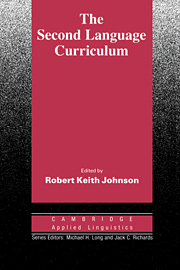Book contents
- Frontmatter
- Contents
- Contributors
- Series editors' preface
- Acknowledgements
- Overview
- I 1 CURRICULUM OVERVIEW
- Chapter 1 A decision-making framework for the coherent language curriculum
- I 2 CURRICULUM PLANNING
- II ENDS/MEANS SPECIFICATION
- III PROGRAMME IMPLEMENTATION
- IV CLASSROOM IMPLEMENTATION
- V EVALUATION
- Bibliography
- Index
Chapter 1 - A decision-making framework for the coherent language curriculum
Published online by Cambridge University Press: 05 October 2012
- Frontmatter
- Contents
- Contributors
- Series editors' preface
- Acknowledgements
- Overview
- I 1 CURRICULUM OVERVIEW
- Chapter 1 A decision-making framework for the coherent language curriculum
- I 2 CURRICULUM PLANNING
- II ENDS/MEANS SPECIFICATION
- III PROGRAMME IMPLEMENTATION
- IV CLASSROOM IMPLEMENTATION
- V EVALUATION
- Bibliography
- Index
Summary
Introduction
In this introductory paper, I have three major aims: first to provide a framework for discussing the language curriculum; second to define the notion of a ‘coherent’ language curriculum, the theme of this book as well as the title of this paper; and third to show how the other papers in this volume and the particular aspects of development they focus upon relate to the curriculum process as a whole.
The word ‘curriculum’ is defined here in its broadest sense, to include all the relevant decision making processes of all the participants. The products of these decision making processes generally exist in some concrete form and can be observed and described: for example policy documents, syllabuses, teacher-training programmes, teaching materials and resources, and teaching and learning acts. The processes themselves are usually more difficult to identify and analyse. They involve such questions as: Who is supposed to make the decisions and who actually does? How are these people selected and what qualifications do they have? What are their terms of reference? What resources in time, money, information and expertise are available to them? etc. Other ‘process’ factors such as prejudice, preconception, ambition or laziness are even harder to examine, but may be no less influential in their effects.
The framework consists of three sets of constraints on curriculum decision making. The first is policy. A curriculum which appears in all other respects to be successful, but which fails to achieve its aims, is hard to justify however much the participants may have benefited from their experience in other ways, for example socially or financially.
- Type
- Chapter
- Information
- The Second Language Curriculum , pp. 1 - 23Publisher: Cambridge University PressPrint publication year: 1989
- 12
- Cited by



